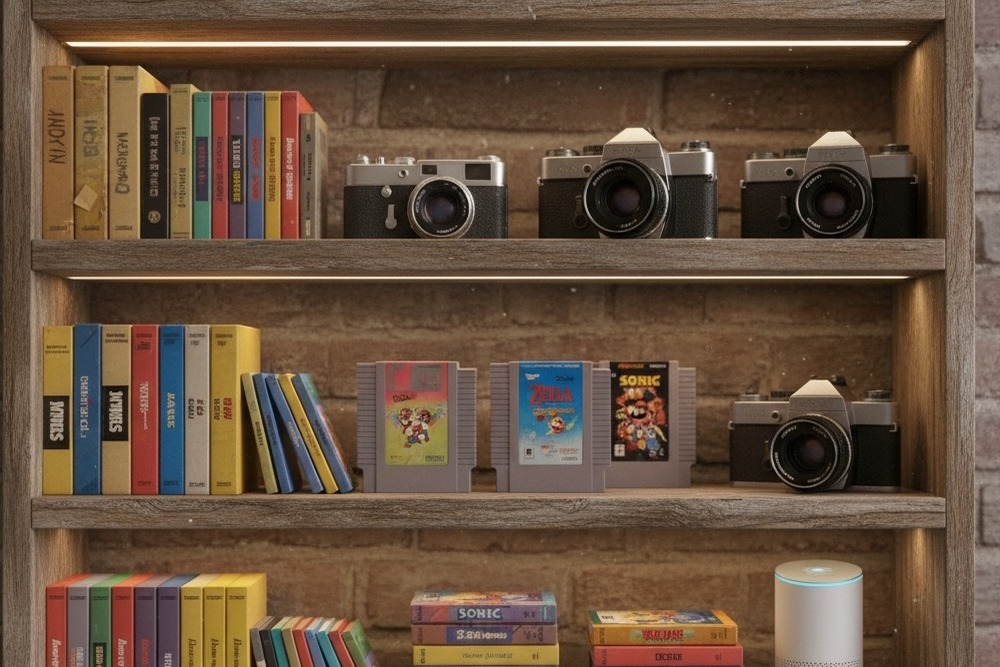How Nostalgia Is Driving the Comeback of Retro Tech
Ethan Sawyer
2025-10-04
6 min read

In an age where smartphones can perform thousands of tasks and artificial intelligence handles everything from customer service to creative writing, something unexpected is happening in our relationship with technology. Instead of exclusively embracing the newest innovations, millions of people are turning backwards, seeking comfort and connection in the warm glow of cathode ray tube monitors, the satisfying click of mechanical keyboards, and the analog warmth of vinyl records spinning on turntables. This phenomenon isn't just about hipster trends or collector hobbies. The resurgence of retro technology represents a deeper cultural shift that reveals how we process rapid technological change and what we truly value in our relationship with the tools that shape our daily lives.
The Psychology Behind Nostalgic Technology
Nostalgia operates as a powerful emotional force that influences purchasing decisions in ways that pure functionality cannot explain. When someone chooses to buy a Polaroid camera in 2025, they're not making a rational decision based on image quality or convenience. Instead, they're investing in an emotional experience that connects them to memories, relationships, and a sense of authenticity that feels absent from digital photography. Research in consumer psychology shows that nostalgic products tap into what psychologists call "social connectedness." The physical act of winding film, waiting for a Polaroid to develop, or carefully placing a needle on a vinyl record creates ritualistic experiences that digital alternatives have streamlined away. These rituals force us to slow down and engage more mindfully with technology, creating stronger emotional memories in the process. The concept of "technological nostalgia" differs from other forms of nostalgia because it often involves longing for technologies that people never actually experienced firsthand. Young adults who grew up with smartphones are buying cassette players and film cameras, drawn to the perceived authenticity and intentionality of analog processes they only know through cultural representations.
The Vinyl Revival as Cultural Blueprint
The vinyl record industry provides the clearest example of how nostalgia can resurrect seemingly obsolete technology. After nearly disappearing in the early 2000s, vinyl sales have grown consistently for over a decade, with younger demographics driving much of the growth. This resurgence occurred despite vinyl's obvious disadvantages compared to digital music: records are expensive, fragile, require dedicated equipment, and offer lower fidelity than high-quality digital formats. The appeal lies in the complete experience that vinyl provides. Album artwork becomes a tangible artifact, the physical act of playing a record creates ceremony around music consumption, and the slight imperfections of analog sound are perceived as warmth rather than limitations. Record stores have become social spaces where music discovery happens through browsing and recommendation rather than algorithm. This pattern has repeated across numerous product categories. Film photography has experienced a remarkable comeback, with companies like Fujifilm reporting increased demand for instant cameras and film stock. The appeal centers on the permanence and intentionality that film requires, contrasting sharply with the ephemeral nature of digital photos that accumulate by the thousands on our devices.

Digital Fatigue and the Desire for Tangibility
The retro tech movement also reflects a broader phenomenon that researchers call "digital fatigue." As our lives become increasingly mediated by screens and cloud services, many people crave physical objects that exist independently of networks and subscriptions. A mechanical watch doesn't need updates, a typewriter can't be hacked, and a vinyl record will play the same way decades from now as it does today. This desire for technological independence has sparked interest in older computing platforms as well. Desktop PCs are experiencing renewed popularity, particularly among younger users who appreciate their modularity, repairability, and the hands-on knowledge required to build and maintain them. The desktop computer represents a form of technological self-reliance that feels increasingly rare in an era of sealed devices and cloud dependency. The gaming industry has embraced this trend through retro console releases and the continued popularity of arcade-style games. Nintendo's classic console re-releases have been hugely successful, tapping into both genuine nostalgia from older players and curiosity from younger ones about gaming's history. These products succeed because they offer curated experiences that feel complete and finite, contrasting with modern gaming's emphasis on continuous updates and online connectivity.
The Role of Social Media in Retro Tech Adoption
Paradoxically, social media platforms have played a crucial role in promoting retro technology adoption. Instagram and TikTok users showcase their vintage cameras, record collections, and analog hobbies, creating aspirational content that positions retro tech as lifestyle choices rather than mere functional tools. The aesthetic appeal of analog processes translates perfectly to visual social media, where the warm tones of film photography or the ritual of brewing coffee with vintage equipment generate engagement and community. This social aspect transforms retro tech from solitary pursuits into shared cultural experiences. Online communities dedicated to film photography, vinyl collecting, or vintage computing provide spaces where enthusiasts can share knowledge, showcase their collections, and maintain social connections around shared interests. These communities often emphasize craftsmanship, patience, and deep knowledge over the immediate gratification that characterizes much of modern technology use.
Economic and Environmental Considerations
The retro tech movement also intersects with growing awareness of planned obsolescence and environmental impact. Older technologies were often built to last decades rather than years, and their continued functionality serves as a critique of contemporary manufacturing practices. A turntable from the 1970s can still provide excellent performance today, while smartphones become obsolete within a few years. This durability appeals to consumers who are increasingly conscious of consumption patterns and waste. Buying vintage or retro equipment often means purchasing items that have already proven their longevity, reducing the environmental impact compared to constantly upgrading modern devices.
The Future of Nostalgic Technology
The comeback of retro tech reveals fundamental human needs that purely functional modern technology sometimes fails to address. The desire for tangible experiences, ritualistic interactions, and technological independence suggests that the most successful future technologies may be those that learn from both digital innovation and analog wisdom. As we continue to navigate rapid technological change, the appeal of retro tech serves as a reminder that progress isn't always about adding features or increasing speed. Sometimes the most valuable technology is that which helps us slow down, connect more deeply with our tools and each other, and maintain a sense of agency in our increasingly automated world. The resurgence of vinyl, film, and analog devices isn't about rejecting progress—it's about ensuring that human values remain central to our technological choices.



